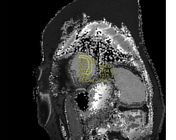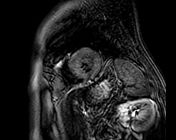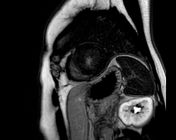Hypertrophic cardiomyopathy - apical pattern with midventricular obstruction
Diagnosis certain
Presentation
Mild dyspnea upon exertion and mild chest pain.
Patient Data
Age: 45
Gender: Male







Download
Info
apical hypertrophic cardiomyopathy with midventricular obstruction.
LGE and PSIR gado both show patchy midwall fibrosis with subendocardial involvement in the apex. Apical subendocardial necrosis may have been involved in chest pain.
No thrombus.
Case Discussion
This pattern of sarcomeric hypertrophic cardiomyopathy is less common than the anteroseptoapical asymmetrical classical one and less common than the inferoseptal pattern one.
Prognosis with this apical pattern is probably worsened due to increased incidence of adverse cardiac events.




 Unable to process the form. Check for errors and try again.
Unable to process the form. Check for errors and try again.